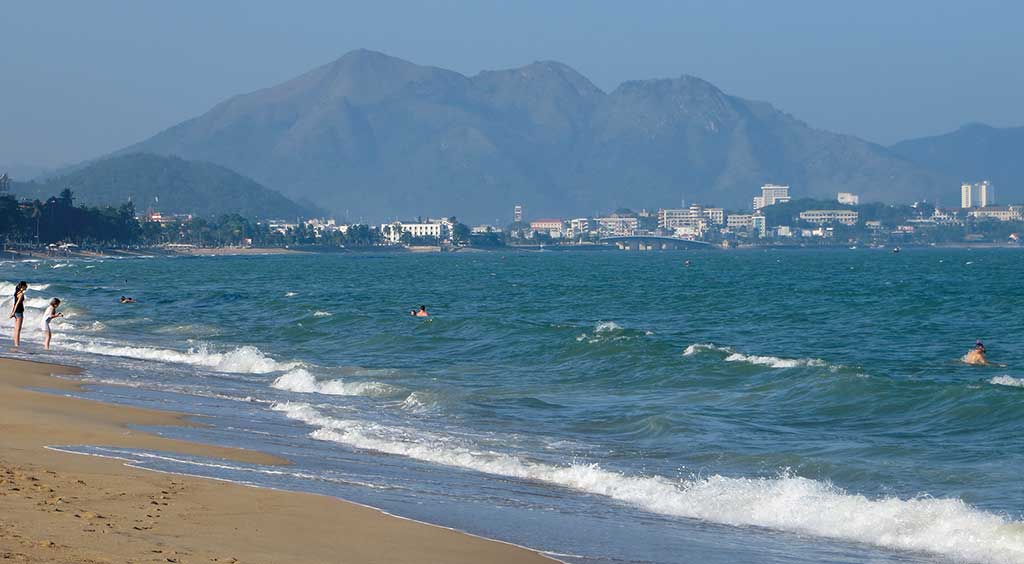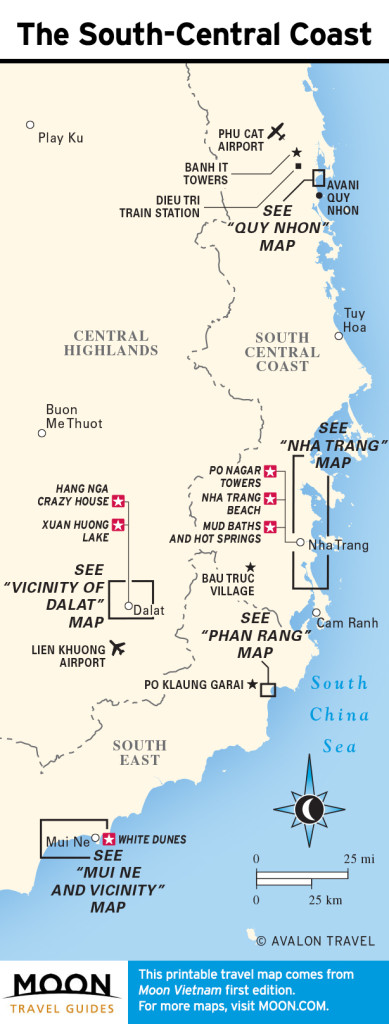A vibrant, sun-soaked shoreline runs unbroken from the tumultuous cliffs of Quy Nhon down to Mui Ne’s bizarre tropical sand dunes. The bulk of Vietnam’s most-visited mainland beaches belong to this region. Rounding out the belly of the “S,” this gently curving stretch of coast is a feast of greens and blues, with lush jungle green palms and azure waters, providing a picture-perfect backdrop for the region’s sleepy fishing villages and bustling city thoroughfares. Whether you’re an adventure junkie plying the surf of Mui Ne, a party animal living it up on the sands of Nha Trang, or just a traveler in search of some good old-fashioned rest and relaxation on the quieter shores of Phan Rang or Quy Nhon, there are plenty of places to lay your towel here.

Nha Trang Beach. Photo © Dana Filek-Gibson.
The major stopover on the south-central coast is Nha Trang, the largest and flashiest of the region’s cities, where sunny beach days give way to all-night parties.Beyond the beach, the south-central coast boasts an equally colorful history as the former kingdom of Champa, an ancient Hindu civilization whose red-brick ruins still dot the shoreline today, and as a thriving part of the nation’s fishing industry, awash with brightly hued wooden boats and miles of wispy white fishing net. Farther inland, 80 miles from shore, the highlands town of Dalat provides an excellent contrast to its coastal cousins, with adventure travel written all over the undulating mountains and dense forests.The major stopover on the south-central coast is Nha Trang, the largest and flashiest of the region’s cities, where sunny beach days give way to all-night parties. Some may venture away from the sand and on to Dalat, gateway to Vietnam’s interior and home to mountainous adventure. Those seeking a more anonymous beach destination will be rewarded at Phan Rang or Quy Nhon, whose peaceful shores can be a much-needed escape from the buzz and chaos of Vietnam’s larger cities without having to take a step off the beaten track.
While parts of this coast enjoy clear skies year-round thanks to a semi-arid climate, south-central Vietnam is at its best from February to April, when the temperature has risen but the rain has yet to arrive. Sunshine prevails through the summer months until August, though the heat during the latter part of this period can get oppressive. The fall is reserved for the rainy season, when winds pick up along the southern part of the coast and cooler weather settles over Nha Trang and Quy Nhon.
Most travelers can hit all the highlights of this region in a little over a week, though you may need more time if you veer off the coast to Dalat. Spend 3-4 days in Nha Trang. If you crave beach time beyond that, spend 2-3 days in Quy Nhon or Phan Rang-Thap Cham. Mui Ne can be substituted as a quieter alternative to popular Nha Trang. Dalat is the polar opposite of the region’s coast towns, and is worth a stay of 2-4 days.

The South-Central Coast
This region spans a large swath of land, so travelers tend to town-hop. Nha Trang can be a base for visiting Quy Nhon or Phan Rang-Thap Cham. Culture vultures and history buffs will breeze through the area fairly quickly, making short stops in each destination to glimpse the pagodas and historical sites scattered along the shore, while beach bums are sure to stick around longer, as this is Vietnam’s prime spot for sun and sand.
Highway 1, the largest national road, is the major route for traveling between the region’s cities.
Excerpted from the First Edition of Moon Vietnam.